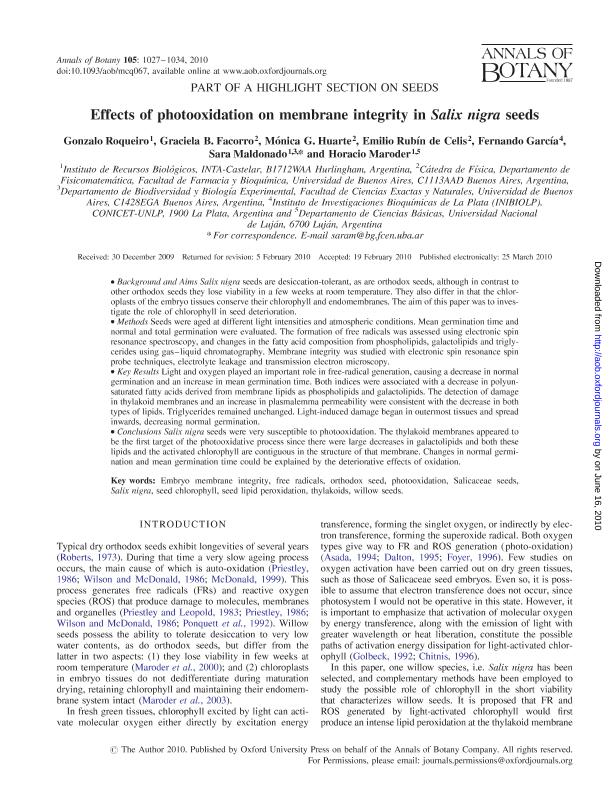Mostrar el registro sencillo del ítem
dc.contributor.author
Roqueiro, Gonzalo

dc.contributor.author
Facorro, Graciela B.
dc.contributor.author
Huarte, Mónica G.
dc.contributor.author
Rubín de Celis, Emilio

dc.contributor.author
Garcia, Carlos Fernando

dc.contributor.author
Maldonado, Sara Beatriz

dc.contributor.author
Maroder, Horacio
dc.date.available
2019-02-21T19:01:20Z
dc.date.issued
2010-06
dc.identifier.citation
Roqueiro, Gonzalo; Facorro, Graciela B.; Huarte, Mónica G.; Rubín de Celis, Emilio; Garcia, Carlos Fernando; et al.; Effects of photooxidation on membrane integrity in Salix nigra seeds; Oxford University Press; Annals of Botany; 105; 6; 6-2010; 1027-1034
dc.identifier.issn
0305-7364
dc.identifier.uri
http://hdl.handle.net/11336/70634
dc.description.abstract
Background and Aims: Salix nigra seeds are desiccation-tolerant, as are orthodox seeds, although in contrast to other orthodox seeds they lose viability in a few weeks at room temperature. They also differ in that the chloroplasts of the embryo tissues conserve their chlorophyll and endomembranes. The aim of this paper was to investigate the role of chlorophyll in seed deterioration. Methods: Seeds were aged at different light intensities and atmospheric conditions. Mean germination time and normal and total germination were evaluated. The formation of free radicals was assessed using electronic spin resonance spectroscopy, and changes in the fatty acid composition from phospholipids, galactolipids and triglycerides using gas-liquid chromatography. Membrane integrity was studied with electronic spin resonance spin probe techniques, electrolyte leakage and transmission electron microscopy. Key Results: Light and oxygen played an important role in free-radical generation, causing a decrease in normal germination and an increase in mean germination time. Both indices were associated with a decrease in polyunsaturated fatty acids derived from membrane lipids as phospholipids and galactolipids. The detection of damage in thylakoid membranes and an increase in plasmalemma permeability were consistent with the decrease in both types of lipids. Triglycerides remained unchanged. Light-induced damage began in outermost tissues and spread inwards, decreasing normal germination. Conclusions: Salix nigra seeds were very susceptible to photooxidation. The thylakoid membranes appeared to be the first target of the photooxidative process since there were large decreases in galactolipids and both these lipids and the activated chlorophyll are contiguous in the structure of that membrane. Changes in normal germination and mean germination time could be explained by the deteriorative effects of oxidation.
dc.format
application/pdf
dc.language.iso
eng
dc.publisher
Oxford University Press

dc.rights
info:eu-repo/semantics/openAccess
dc.rights.uri
https://creativecommons.org/licenses/by-nc-sa/2.5/ar/
dc.subject
Embryo Membrane Integrity
dc.subject
Free Radicals
dc.subject
Orthodox Seed
dc.subject
Photooxidation
dc.subject
Salicaceae Seeds
dc.subject
Salix Nigra
dc.subject
Seed Chlorophyll
dc.subject
Seed Lipid Peroxidation
dc.subject
Thylakoids
dc.subject
Willow Seeds
dc.subject.classification
Otras Ciencias Biológicas

dc.subject.classification
Ciencias Biológicas

dc.subject.classification
CIENCIAS NATURALES Y EXACTAS

dc.title
Effects of photooxidation on membrane integrity in Salix nigra seeds
dc.type
info:eu-repo/semantics/article
dc.type
info:ar-repo/semantics/artículo
dc.type
info:eu-repo/semantics/publishedVersion
dc.date.updated
2019-01-02T18:23:03Z
dc.journal.volume
105
dc.journal.number
6
dc.journal.pagination
1027-1034
dc.journal.pais
Reino Unido

dc.journal.ciudad
Oxford
dc.description.fil
Fil: Roqueiro, Gonzalo. Instituto Nacional de Tecnología Agropecuaria. Centro de Investigación de Recursos Naturales. Instituto de Recursos Biológicos; Argentina
dc.description.fil
Fil: Facorro, Graciela B.. Universidad Nacional de la Plata. Facultad de Ingeniería. Departamento de Fisicomatemática; Argentina
dc.description.fil
Fil: Huarte, Mónica G.. Universidad Nacional de la Plata. Facultad de Ingeniería. Departamento de Fisicomatemática; Argentina
dc.description.fil
Fil: Rubín de Celis, Emilio. Universidad Nacional de la Plata. Facultad de Ingeniería. Departamento de Fisicomatemática; Argentina. Consejo Nacional de Investigaciones Científicas y Técnicas; Argentina
dc.description.fil
Fil: Garcia, Carlos Fernando. Consejo Nacional de Investigaciones Científicas y Técnicas. Centro Científico Tecnológico Conicet - La Plata. Instituto de Investigaciones Bioquímicas de La Plata "Prof. Dr. Rodolfo R. Brenner". Universidad Nacional de la Plata. Facultad de Ciencias Médicas. Instituto de Investigaciones Bioquímicas de La Plata "Prof. Dr. Rodolfo R. Brenner"; Argentina
dc.description.fil
Fil: Maldonado, Sara Beatriz. Instituto Nacional de Tecnología Agropecuaria. Centro de Investigación de Recursos Naturales. Instituto de Recursos Biológicos; Argentina. Consejo Nacional de Investigaciones Científicas y Técnicas; Argentina
dc.description.fil
Fil: Maroder, Horacio. Instituto Nacional de Tecnología Agropecuaria. Centro de Investigación de Recursos Naturales. Instituto de Recursos Biológicos; Argentina. Universidad Nacional de Luján. Departamento de Ciencias Básicas; Argentina
dc.journal.title
Annals of Botany

dc.relation.alternativeid
info:eu-repo/semantics/altIdentifier/doi/http://dx.doi.org/10.1093/aob/mcq067
dc.relation.alternativeid
info:eu-repo/semantics/altIdentifier/url/https://academic.oup.com/aob/article/105/6/1027/94387
Archivos asociados
